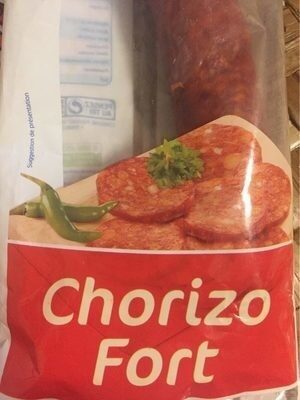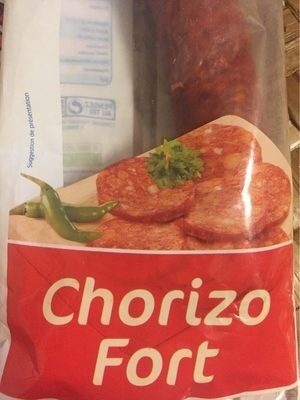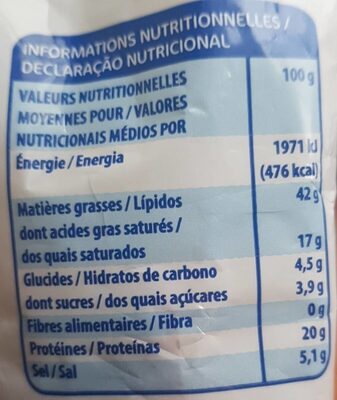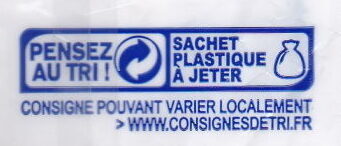Help us make food transparency the norm!
As a non-profit organization, we depend on your donations to continue informing consumers around the world about what they eat.
The food revolution starts with you!
Chorizo Fort - Eco+ - 250 g
Chorizo Fort - Eco+ - 250 g
Barcode: 3450970123914 (EAN / EAN-13)
Quantity: 250 g
Packaging: Plastic, Bag, fr:Sachet en plastique
Brands: Eco+
Categories: Meats and their products, Meats, Prepared meats, Cured sausages, Chorizo
Labels, certifications, awards:
Green Dot
Origin of ingredients: European Union
Manufacturing or processing places: France
Traceability code: FR 81.144.022 CE - Lescure-d'Albigeois (Tarn, France), FR 55.545.002 CE - Verdun (Meuse, France)
Stores: Leclerc
Countries where sold: France
Matching with your preferences
Health
Ingredients
-
23 ingredients
: Viande et gras de porc (origine: UE); sel ; dextrose ; épices et plantes aromatiques (dont piment de Cayenne 0,3 %); stabilisant : E450; colorants : E120, E160c; antioxydants: E300, E316; arômes naturels; conservateurs: E250, E252; ferments. Enveloppe : boyau naturel de porc; conservateurs : E202, E235.
Food processing
-
Ultra processed foods
Elements that indicate the product is in the 4 - Ultra processed food and drink products group:
- Additive: E120 - Cochineal
- Additive: E160c - Paprika extract
- Additive: E450 - Diphosphates
- Ingredient: Colour
- Ingredient: Dextrose
- Ingredient: Flavouring
- Ingredient: Glucose
Food products are classified into 4 groups according to their degree of processing:
- Unprocessed or minimally processed foods
- Processed culinary ingredients
- Processed foods
- Ultra processed foods
The determination of the group is based on the category of the product and on the ingredients it contains.
Additives
-
E120 - Cochineal
Carminic acid: Carminic acid -C22H20O13- is a red glucosidal hydroxyanthrapurin that occurs naturally in some scale insects, such as the cochineal, Armenian cochineal, and Polish cochineal. The insects produce the acid as a deterrent to predators. An aluminum salt of carminic acid is the coloring agent in carmine. Synonyms are C.I. 75470 and C.I. Natural Red 4. The chemical structure of carminic acid consists of a core anthraquinone structure linked to a glucose sugar unit. Carminic acid was first synthesized in the laboratory by organic chemists in 1991.Source: Wikipedia
-
E202 - Potassium sorbate
Potassium sorbate (E202) is a synthetic food preservative commonly used to extend the shelf life of various food products.
It works by inhibiting the growth of molds, yeast, and some bacteria, preventing spoilage. When added to foods, it helps maintain their freshness and quality.
Some studies have shown that when combined with nitrites, potassium sorbate have genotoxic activity in vitro. However, potassium sorbate is generally recognized as safe (GRAS) by regulatory authorities.
-
E235 - Natamycin
Natamycin: Natamycin, also known as pimaricin, is an antifungal medication used to treat fungal infections around the eye. This includes infections of the eyelids, conjunctiva, and cornea. It is used as eyedrops. Natamycin is also used in the food industry as a preservative.Allergic reactions may occur. It is unclear if medical use during pregnancy or breastfeeding is safe. It is in the macrolide and polyene families of medications. It results in fungal death by altering the cell membrane.Natamycin was discovered in 1955 and approved for medical use in the United States in 1978. It is on the World Health Organization's List of Essential Medicines, the most effective and safe medicines needed in a health system. The wholesale cost in the developing world is between US$92.90 and 126.72 per 5-ml bottle as of 2015. It is produced by fermentation of the bacterium Streptomyces natalensis.Source: Wikipedia
-
E250 - Sodium nitrite
Sodium nitrite: Sodium nitrite is the inorganic compound with the chemical formula NaNO2. It is a white to slightly yellowish crystalline powder that is very soluble in water and is hygroscopic. It is a useful precursor to a variety of organic compounds, such as pharmaceuticals, dyes, and pesticides, but it is probably best known as a food additive to prevent botulism. It is on the World Health Organization's List of Essential Medicines, the most important medications needed in a basic health system.Nitrate or nitrite -ingested- under conditions that result in endogenous nitrosation has been classified as "probably carcinogenic to humans" by International Agency for Research on Cancer -IARC-.Source: Wikipedia
-
E252 - Potassium nitrate
Potassium nitrate: Potassium nitrate is a chemical compound with the chemical formula KNO3. It is an ionic salt of potassium ions K+ and nitrate ions NO3−, and is therefore an alkali metal nitrate. It occurs in nature as a mineral, niter. It is a source of nitrogen, from which it derives its name. Potassium nitrate is one of several nitrogen-containing compounds collectively referred to as saltpeter or saltpetre. Major uses of potassium nitrate are in fertilizers, tree stump removal, rocket propellants and fireworks. It is one of the major constituents of gunpowder -black powder- and has been used since the Middle Ages as a food preservative.Source: Wikipedia
-
E316 - Sodium erythorbate
Sodium erythorbate: Sodium erythorbate -C6H7NaO6- is a food additive used predominantly in meats, poultry, and soft drinks. Chemically, it is the sodium salt of erythorbic acid. When used in processed meat such as hot dogs and beef sticks, it increases the rate at which nitrite reduces to nitric oxide, thus facilitating a faster cure and retaining the pink coloring. As an antioxidant structurally related to vitamin C, it helps improve flavor stability and prevents the formation of carcinogenic nitrosamines. When used as a food additive, its E number is E316. The use of erythorbic acid and sodium erythorbate as a food preservative has increased greatly since the U.S. Food and Drug Administration banned the use of sulfites as preservatives in foods intended to be eaten fresh -such as ingredients for fresh salads- and as food processors have responded to the fact that some people are allergic to sulfites. It can also be found in bologna, and is occasionally used in beverages, baked goods, and potato salad.Sodium erythorbate is produced from sugars derived from different sources, such as beets, sugar cane, and corn. An urban myth claims that sodium erythorbate is made from ground earthworms; however, there is no truth to the myth. It is thought that the genesis of the legend comes from the similarity of the chemical name to the words earthworm and bait.Alternative applications include the development of additives that could be utilized as anti-oxidants in general. For instance, this substance has been implemented in the development of corrosion inhibitors for metals and it has been implemented in active packaging.Sodium erythorbate is soluble in water. The pH of the aqueous solution of the sodium salt is between 5 and 6. A 10% solution, made from commercial grade sodium erythorbate, may have a pH of 7.2 to 7.9. In its dry, crystalline state it is nonreactive. But, when in solution with water it readily reacts with atmospheric oxygen and other oxidizing agents, which makes it a valuable antioxidant.Source: Wikipedia
-
E450 - Diphosphates
Diphosphates (E450) are food additives often utilized to modify the texture of products, acting as leavening agents in baking and preventing the coagulation of canned food.
These salts can stabilize whipped cream and are also found in powdered products to maintain their flow properties. They are commonly present in baked goods, processed meats, and soft drinks.
Derived from phosphoric acid, they're part of our daily phosphate intake, which often surpasses recommended levels due to the prevalence of phosphates in processed foods and drinks.
Excessive phosphate consumption is linked to health issues, such as impaired kidney function and weakened bone health. Though diphosphates are generally regarded as safe when consumed within established acceptable daily intakes, it's imperative to monitor overall phosphate consumption to maintain optimal health.
Ingredients analysis
-
Palm oil free
No ingredients containing palm oil detected
-
Non-vegan
Non-vegan ingredients: fr:Viande et gras de porc, E120, fr:Boyau naturel de porc
-
Non-vegetarian
Non-vegetarian ingredients: fr:Viande et gras de porc, E120, fr:Boyau naturel de porc
-
Details of the analysis of the ingredients
: Viande et gras de porc, sel, dextrose, épices et plantes aromatiques (dont piment de Cayenne 0.3%), stabilisant (e450), colorants (e120), e160c, antioxydants (e300), e316, arômes naturels, conservateurs (e250), e252, ferments, Enveloppe (boyau naturel de porc), conservateurs (e202), e235- Viande et gras de porc -> fr:viande-et-gras-de-porc - vegan: no - vegetarian: no - ciqual_proxy_food_code: 28205 - percent_min: 85.9 - percent_max: 99.1
- sel -> en:salt - vegan: yes - vegetarian: yes - ciqual_food_code: 11058 - percent_min: 0.3 - percent_max: 5.1
- dextrose -> en:dextrose - vegan: yes - vegetarian: yes - ciqual_proxy_food_code: 31016 - percent_min: 0.3 - percent_max: 5.1
- épices et plantes aromatiques -> en:herbs-and-spices - vegan: yes - vegetarian: yes - percent_min: 0.3 - percent_max: 0.3
- dont piment de Cayenne -> en:cayenne-pepper - vegan: yes - vegetarian: yes - ciqual_food_code: 11088 - percent_min: 0.3 - percent: 0.3 - percent_max: 0.3
- stabilisant -> en:stabiliser - percent_min: 0 - percent_max: 0.3
- e450 -> en:e450 - vegan: yes - vegetarian: yes - percent_min: 0 - percent_max: 0.3
- colorants -> en:colour - percent_min: 0 - percent_max: 0.3
- e120 -> en:e120 - vegan: no - vegetarian: no - percent_min: 0 - percent_max: 0.3
- e160c -> en:e160c - vegan: yes - vegetarian: yes - percent_min: 0 - percent_max: 0.3
- antioxydants -> en:antioxidant - percent_min: 0 - percent_max: 0.3
- e300 -> en:e300 - vegan: yes - vegetarian: yes - percent_min: 0 - percent_max: 0.3
- e316 -> en:e316 - vegan: yes - vegetarian: yes - percent_min: 0 - percent_max: 0.3
- arômes naturels -> en:natural-flavouring - vegan: maybe - vegetarian: maybe - percent_min: 0 - percent_max: 0.3
- conservateurs -> en:preservative - percent_min: 0 - percent_max: 0.3
- e250 -> en:e250 - vegan: yes - vegetarian: yes - percent_min: 0 - percent_max: 0.3
- e252 -> en:e252 - vegan: yes - vegetarian: yes - percent_min: 0 - percent_max: 0.3
- ferments -> en:ferment - vegan: maybe - vegetarian: maybe - percent_min: 0 - percent_max: 0.3
- Enveloppe -> en:casing - percent_min: 0 - percent_max: 0.3
- boyau naturel de porc -> fr:boyau-naturel-de-porc - vegan: no - vegetarian: no - percent_min: 0 - percent_max: 0.3
- conservateurs -> en:preservative - percent_min: 0 - percent_max: 0.3
- e202 -> en:e202 - vegan: yes - vegetarian: yes - percent_min: 0 - percent_max: 0.3
- e235 -> en:e235 - vegan: yes - vegetarian: yes - percent_min: 0 - percent_max: 0.3
Nutrition
-
Bad nutritional quality
⚠ ️Warning: the amount of fruits, vegetables and nuts is not specified on the label, it was estimated from the list of ingredients: 0This product is not considered a beverage for the calculation of the Nutri-Score.
Positive points: 0
- Proteins: 5 / 5 (value: 20, rounded value: 20)
- Fiber: 0 / 5 (value: 0, rounded value: 0)
- Fruits, vegetables, nuts, and colza/walnut/olive oils: 0 / 5 (value: 0, rounded value: 0)
Negative points: 25
- Energy: 5 / 10 (value: 1971, rounded value: 1971)
- Sugars: 0 / 10 (value: 3.9, rounded value: 3.9)
- Saturated fat: 10 / 10 (value: 17, rounded value: 17)
- Sodium: 10 / 10 (value: 2040, rounded value: 2040)
The points for proteins are not counted because the negative points are greater or equal to 11.
Nutritional score: (25 - 0)
Nutri-Score:
-
Nutrient levels
-
Fat in high quantity (42%)
What you need to know- A high consumption of fat, especially saturated fats, can raise cholesterol, which increases the risk of heart diseases.
Recommendation: Limit the consumption of fat and saturated fat- Choose products with lower fat and saturated fat content.
-
Saturated fat in high quantity (17%)
What you need to know- A high consumption of fat, especially saturated fats, can raise cholesterol, which increases the risk of heart diseases.
Recommendation: Limit the consumption of fat and saturated fat- Choose products with lower fat and saturated fat content.
-
Sugars in low quantity (3.9%)
What you need to know- A high consumption of sugar can cause weight gain and tooth decay. It also augments the risk of type 2 diabetes and cardio-vascular diseases.
Recommendation: Limit the consumption of sugar and sugary drinks- Sugary drinks (such as sodas, fruit beverages, and fruit juices and nectars) should be limited as much as possible (no more than 1 glass a day).
- Choose products with lower sugar content and reduce the consumption of products with added sugars.
-
Salt in high quantity (5.1%)
What you need to know- A high consumption of salt (or sodium) can cause raised blood pressure, which can increase the risk of heart disease and stroke.
- Many people who have high blood pressure do not know it, as there are often no symptoms.
- Most people consume too much salt (on average 9 to 12 grams per day), around twice the recommended maximum level of intake.
Recommendation: Limit the consumption of salt and salted food- Reduce the quantity of salt used when cooking, and don't salt again at the table.
- Limit the consumption of salty snacks and choose products with lower salt content.
-
-
Nutrition facts
Nutrition facts As sold
for 100 g / 100 mlCompared to: Chorizo Energy 1,971 kj
(476 kcal)+17% Fat 42 g +25% Saturated fat 17 g +32% Carbohydrates 4.5 g +76% Sugars 3.9 g +179% Fiber 0 g -100% Proteins 20 g -11% Salt 5.1 g +49% Fruits‚ vegetables‚ nuts and rapeseed‚ walnut and olive oils (estimate from ingredients list analysis) 0 %
Environment
-
Eco-Score D - High environmental impact
⚠ ️Select a country in order to include the full impact of transportation.The Eco-Score is an experimental score that summarizes the environmental impacts of food products.→ The Eco-Score was initially developped for France and it is being extended to other European countries. The Eco-Score formula is subject to change as it is regularly improved to make it more precise and better suited to each country.Life cycle analysis
-
Average impact of products of the same category: D (Score: 35/100)
Category: Spicy pork sausage with red pepper, no precision
Category: Spicy pork sausage with red pepper, no precision
- PEF environmental score: 0.89 (the lower the score, the lower the impact)
- including impact on climate change: 6.17 kg CO2 eq/kg of product
Stage Impact Agriculture
78.5 %Processing
14.4 %Packaging
0.5 %Transportation
1.8 %Distribution
1.0 %Consumption
3.8 %
Bonuses and maluses
-
Origins of ingredients with a high impact
Malus: -5
Environmental policy: -5
Transportation: 0
Origin of the product and/or its ingredients % of ingredients Impact European Union 100 %High
-
Packaging with a medium impact
Malus: -10
Shape Material Recycling Impact 1 Bag Plastic Discard High
Eco-Score for this product
-
Impact for this product: D (Score: 20/100)
Product: Chorizo Fort - Eco+ - 250 g
Life cycle analysis score: 35
Sum of bonuses and maluses: -15
Final score: 20/100
-
Carbon footprint
-
Equal to driving 3.2 km in a petrol car
617 g CO² per 100g of product
The carbon emission figure comes from ADEME's Agribalyse database, for the category: Spicy pork sausage with red pepper, no precision (Source: ADEME Agribalyse Database)
Stage Impact Agriculture
82.7 %Processing
10.3 %Packaging
1.6 %Transportation
3.3 %Distribution
0.6 %Consumption
1.5 %
Packaging
-
Packaging with a medium impact
-
Packaging parts
1 x Bag (Plastic)
-
Packaging materials
Material % Packaging weight Packaging weight per 100 g of product Plastic
-
Transportation
-
Origins of ingredients
Origins of ingredients with a high impact
Origin of the product and/or its ingredients % of ingredients Impact European Union 100 %High
Report a problem
-
Incomplete or incorrect information?
Category, labels, ingredients, allergens, nutritional information, photos etc.
If the information does not match the information on the packaging, please complete or correct it. Open Food Facts is a collaborative database, and every contribution is useful for all.
Data sources
Product added on by kiliweb
Last edit of product page on by kiliweb.
Product page also edited by cbprimula, date-limite-app, openfoodfacts-contributors, packbot, quentinbrd, roboto-app, segundo, yuka.DItgH4CyPOoqR_qNw98y7BOAMvzKINRzNXoToQ, yuka.sY2b0xO6T85zoF3NwEKvlhNcbvr482qYbB_ipm2L3uq1Fr-zPNpr04H1Y6s, yuka.sY2b0xO6T85zoF3NwEKvlml4bf39syniakPhpXC5__2NKMfmc95D4LGgL6s.












